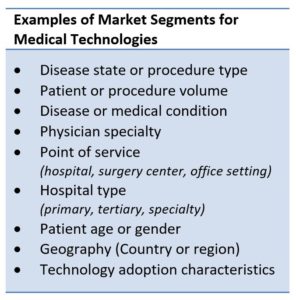Targeting and Market Segmentation
 Identifying and targeting market segments which will produce a steeper early adoption curve for your technology is vital to obtaining strong start out of the blocks. Assessing differing market segments should not only be solely based upon the market potential, but also on the potential barriers to entry which may exist within these segments. While many medical technology have the potential to be used across a number of market segments. Understanding which of these segments represents the greatest opportunity when the barriers to entry are factored into the equation requires a true understanding of the marketplace.
Identifying and targeting market segments which will produce a steeper early adoption curve for your technology is vital to obtaining strong start out of the blocks. Assessing differing market segments should not only be solely based upon the market potential, but also on the potential barriers to entry which may exist within these segments. While many medical technology have the potential to be used across a number of market segments. Understanding which of these segments represents the greatest opportunity when the barriers to entry are factored into the equation requires a true understanding of the marketplace.
 Market segments with the highest number of patients or procedural volumes may not always represent the best “first” markets to approach. These segments are often associated with greater competitive pressures due to the market opportunities they represent, or may be associated with higher visibility within a hospital setting from either a product approval or cost-cutting perspective. The need to prove clinical superiority and the potential for cost-savings at a provider level increases with the cost of the medical technology along with the applicable number of patients or procedures which would be targeted within the hospital. Spending months trying to get a product through a hospital’s new product committee not only slows the adoption of the technology and the associated revenue growth, but also negatively impacts the moral of the sales representative.
Market segments with the highest number of patients or procedural volumes may not always represent the best “first” markets to approach. These segments are often associated with greater competitive pressures due to the market opportunities they represent, or may be associated with higher visibility within a hospital setting from either a product approval or cost-cutting perspective. The need to prove clinical superiority and the potential for cost-savings at a provider level increases with the cost of the medical technology along with the applicable number of patients or procedures which would be targeted within the hospital. Spending months trying to get a product through a hospital’s new product committee not only slows the adoption of the technology and the associated revenue growth, but also negatively impacts the moral of the sales representative.
Segmenting customers by technology adoption characteristics is also important. Targeting customers who routinely try newer technology before their peers is a much easier path to success than attempting to enter the market via customers with a “wait and see attitude.” Focusing initial launch activities towards early adopters who are quick to understand the potential benefits of the technology and limiting efforts directed at late adopters who require substantial clinical experience and more scientific evidence will maximize resources and drive initial sales growth.
The Atticus Group can help you to identify market segments which are associated with a greater level of clinical need for what your technology offers or where the characteristics of the segment lend it to adopting the technology quicker. We can also assist with this process by identifying available data which can support targeting or segmentation based on market demographics or geography.
By focusing at first on subsegments of a certain type of procedure or patient population where a technology may be perceived (or actually have) a greater clinical benefit can lead to expanded product use when the benefits of the technology in the initial sub-segment have been realized. Choosing at first to target a patient population or procedure with a smaller market potential where the technology device has a greater clinical benefit can establish the technology and the brand in the marketplace and allow for easier entry into future market segments.
 Identifying and targeting market segments which will produce a steeper early adoption curve for your technology is vital to obtaining strong start out of the blocks. Assessing differing market segments should not only be solely based upon the market potential, but also on the potential barriers to entry which may exist within these segments. While many medical technology have the potential to be used across a number of market segments. Understanding which of these segments represents the greatest opportunity when the barriers to entry are factored into the equation requires a true understanding of the marketplace.
Identifying and targeting market segments which will produce a steeper early adoption curve for your technology is vital to obtaining strong start out of the blocks. Assessing differing market segments should not only be solely based upon the market potential, but also on the potential barriers to entry which may exist within these segments. While many medical technology have the potential to be used across a number of market segments. Understanding which of these segments represents the greatest opportunity when the barriers to entry are factored into the equation requires a true understanding of the marketplace.
Market segments with the highest number of patients or procedural volumes may not always represent the best “first” markets to approach. These segments are often associated with greater competitive pressures due to the market opportunities they represent, or may be associated with higher visibility within a hospital setting from either a product approval or cost-cutting perspective. The need to prove clinical superiority and the potential for cost-savings at a provider level increases with the cost of the medical technology along with the applicable number of patients or procedures which would be targeted within the hospital. Spending months trying to get a product through a hospital’s new product committee not only slows the adoption of the technology and the associated revenue growth, but also negatively impacts the moral of the sales representative. Segmenting customers by technology adoption characteristics is also important. Targeting customers who routinely try newer technology before their peers is a much easier path to success than attempting to enter the market via customers with a “wait and see attitude.” Focusing initial launch activities towards early adopters who are quick to understand the potential benefits of the technology and limiting efforts directed at late adopters who require substantial clinical experience and more scientific evidence will maximize resources and drive initial sales growth.
Segmenting customers by technology adoption characteristics is also important. Targeting customers who routinely try newer technology before their peers is a much easier path to success than attempting to enter the market via customers with a “wait and see attitude.” Focusing initial launch activities towards early adopters who are quick to understand the potential benefits of the technology and limiting efforts directed at late adopters who require substantial clinical experience and more scientific evidence will maximize resources and drive initial sales growth.
The Atticus Group can help you to identify market segments which are associated with a greater level of clinical need for what your technology offers or where the characteristics of the segment lend it to adopting the technology quicker. We can also assist with this process by identifying available data which can support targeting or segmentation based on market demographics or geography.
By focusing at first on subsegments of a certain type of procedure or patient population where a technology may be perceived (or actually have) a greater clinical benefit can lead to expanded product use when the benefits of the technology in the initial sub-segment have been realized. Choosing at first to target a patient population or procedure with a smaller market potential where the technology device has a greater clinical benefit can establish the technology and the brand in the marketplace and allow for easier entry into future market segments.
